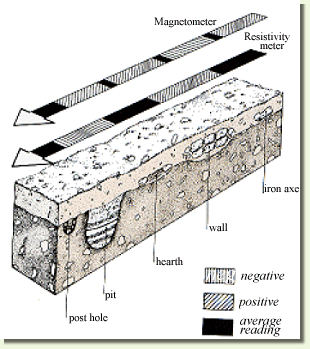
|
How does an archaeologist map out a site before the dig begins?
Non-destructive subsurface testing

|
The two main methods of mapping an area before the dig begins, the resistivity meter and the magnetometer. The black section of the arrows indicates an average background reading; diagonal stripes indicate a stronger magnetic field or electrical resistance; vertical stripes indicate lower magnetism or resistance. As you can see, in this case the resistivity meter records only the pit and wall, where as the magnetometer also detects the iron axe and the hearth. Niether instrument is able to detect features such as the post hole.
|
a.) Magnetometry
- Detects slight variations in the earth's magnetic field.
- i.e.) Lime stone wall > low magnetic property
- i.e.) Iron > high magnetic property
b.) Soil Resistivity
- Detects slight variations in the soil's resistance to electricity, by passing electricity between electrodes in the ground then measuring and recording any variations.
c.) Ground penetrating radar
- Detects differential reflection of radar, similar to the way sonar is used in boats.
|



